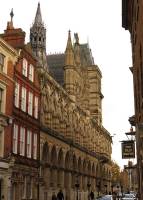

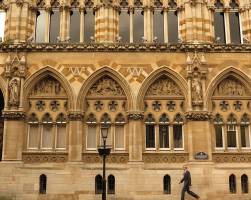
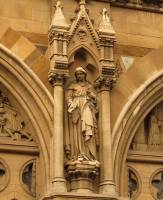
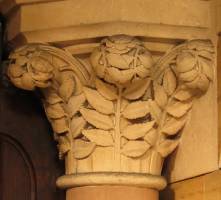
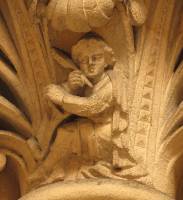
The Guildhall in Northampton is an excellent and uncommon example of a High Victorian building with a complete decorative sculpture scheme encrusting the building. Architectural sculpture is a theme of this website (see this page for links to various related pages) and it seemed time to have another decorated building as sculpture of the month.
The Guildhall is a Gothic pile in a beautiful honey-coloured stone, with lighter and darker umber elements to give a variation and richness of hue - the time to visit is when the sun is low in the sky and lights up the building with a warmth and depth of colour, as shown in the pictures on this page. Northampton Guildhall is essentially a two-storey building some 14 bays wide on the ground floor, with a third storey within a gable, and an imposing clock tower which is actually not much higher than the steep mansard roofs. The building is pleasingly asymmetrical, with the entrance occupying the middle of the right hand side as we look at it, three bays of entrance, two bays either side, then above, a clear run of 7 bays with a balcony above the entrance, and the clock tower above that. On the left of this, we see three further bays given some prominence not by projecting them, but by making them the base of the gable grouping: there are either two wide bays on the upper storey, or they could be described as two pairs of coupled bays each pair under a single rounded arch. The flat gable then has four narrow Gothic windows crammed in, and to the sides are pinnacles, as we might find on a Tudor Gothic tower. Finally, to the left are a further four bays, one of which is an entrance, and above, a continuation of the mansard roof, so binding the whole together; atop this is an extra spire, most spiky and reminiscent of one of the central spires of the Houses of Parliament building. The whole point is that instead of facing onto some great square, Northamptonís Guildhall faces onto a street (though it is called St Giles Square), wide but not wide enough to get any distance to see the whole building. Guildhall Road goes off southwards from the right hand side, so the right hand side of the building is the part which is most imposing. But that extra spire on the left, though it cannot really be seen to advantage from in front, gives the most picturesque oblique view of the building when seen walking along George Street.
E. W. Godwin was the architect, and the building was put up from 1861-64, the westward extension being the work of J.W. Jeffery and M. Holding in 1889-92. Holding, incidentally, was also the architect of the Queen Anneish brick building to the west of the Guildhall.
Now to the sculpture. The largest decorative features are the statues of great men placed on the upper storey between the windows, 14 of them, with two more above the ground floor windows under the gable, and an angel at the very top of that same gable. Then under the Gothic arches on the ground floor which have windows rather than entrances, thus 10 in all, the tops are filled with small figure sculpture in lively alto-relievo scenes. The third decorative sculptural element, on a smaller scale again, consists of the ground floor pillar capitals, supporting each tall Gothic bay and inside the porch. Other minor repeating decoration abounds, all combining to add to the richness of the appearance of the building overall.
We start with the row of 14 statues across the frontage of the building at the upper floor level, together with the two lower ones and the one on the gable. The sculptor was Richard Boulton, whose firm, based in Cheltenham, specialised in sculpture and woodwork furnishings for churches.
Thomas a Becket, Queen Eleanor, Sir Thomas White and John Dryden. 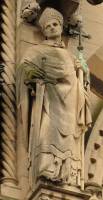
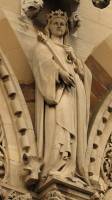
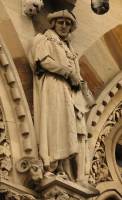
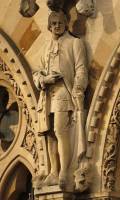
Thomas a Becket, Queen Eleanor, Sir Thomas White and John Dryden are the first four statues from the left, seen above (click to enlarge in the usual way). The statue of Sir Thomas White is particularly good, and rather austere. Queen Eleanor, of course, is famous for the Eleanor Crosses put up after her death by Edward I, of which just three survive today. See this page for the one at Hardingstone near to Northampton, and see this page for more on the Eleanor crosses in general.
Saint Andrew, Saint George and Saint Patrick. 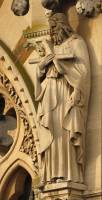


The statues of Saint Andrew, Saint George and Saint Patrick come next. But Saint David, as patron saint of Wales, is curiously absent. Saint Andrew has his cross of course, Saint Patrick has two snakes writhing up his gown, and for England, Saint George appears to be still in battle, but all we can see of the dragon is his head, necessitated for compositional reasons. Saint George and the Dragon is a particularly frequent subject for statues in England, unsurprisingly, and there is a page about statues of him here.
Statues towards right hand end, various kings and Queen Victoria. 


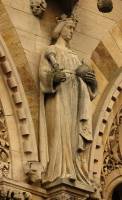


The statues towards the right hand side include various Kings and Queen Victoria, shown above. The kings include Richard I, Henry III, Edward I, Henry VII and Edward IV, and it is an interesting exercise to attempt to work out who they are from their clothing and accoutrements. We note that the Queen Victoria statue shows her rather younger than the more familiar, solid portraits of her later years.
Two statues of Justice, Mercy, and the archangel Michael. 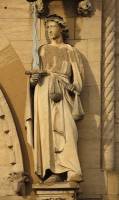
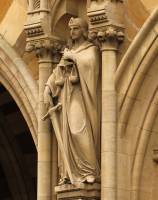
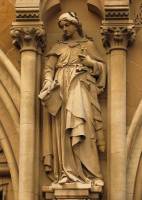
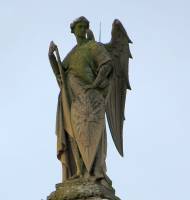
Our last full size statues are allegorical figures of Justice and Mercy, and the summit figure of the Archangel Michael. The first floor figures are a pair: Justice, with her balance and sword, and, Mercy, also with a sword, but wrapped up to show that she is restraining herself from using it. Curiously, the right hand side has as the last figure another Justice, this time with her sword raised rather than with its point resting on the ground, and with a wonderfully wavy edge. We thus have two statues of Justice on the frontage of the building: really rather unusual. Incidentally, the Justice at first floor level is by far the superior statue. The Archangel Michael statue has become somewhat worn due to its exposed position at the very top, but the spiky wings still presents a good silhouette.
This smaller-scale work is by a different sculptor, T. Nicholls, who may be Thomas Nicholls, who worked largely for the architect William Burges. The first three of the tympana are all calm in mood, with the figures standing or kneeling or sitting. You will need to click to enlarge to appreciate them, but it is notable how appropriately scaled they are, so that even from a distance and down below, a completely clear view of the scene and its five or so individual figures is obtained. The treatment is illustrative, kept relatively simple, and yet the sculptor manages to fit in some charming details, for instance the carved woodwork, little leaves on the oak trees, and a curtain rail in the third picture.
Of these next four, the two in the centre are the liveliest, with vigorous action.In both cases a triangular composition is used rather than the vertical lines of the previous examples. The fire scene is excellent; the principal figure is the woman in the centre, crying out for help, arms raised. To the left as we look at the scene, a man almost lying on the ground raises one arm to shield himself from the flames (you will have to click to enlarge to see the mouse fleeing the scene). To the right, another man flees holding some burden above his head, and a fireman heaves his pumping engine closer to the fire. The battle scene is equally dramatic, with the focus on the single combat between the knight on horseback and his lunging opponent who puts one foot onto a fallen horse to provide extra leverage and height.
These last three scenes again combine well-posed figures with nice detailing. Note especially the candlelit left hand scene, with the stamping of a charter resting on a table with embroidered tablecloth, the central scene with its pair of dogs, and the splendid hats of the female figures, and to the right, the expressive poses of the two camps of figures, particularly the cleric on the right.
The capitals to the pillars of the ground floor, facing out to the street, and within the open entrance to the building, are carved with an astonishing range of small figures and imaginative leafy designs. They are again by the sculptor Richard Boulton. Here, below, is a view of this entrance porch, with its entrancing arches, like some medieval crypt of a great church. Within this area are three panels commemorating the Northamptonshire soldiers who fought in the Boer War: one of these is also pictured.
Entrance to the Guildhall, sculptural detail, and Boer War panel. 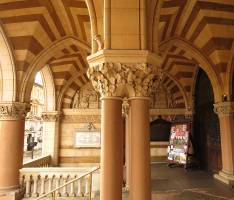
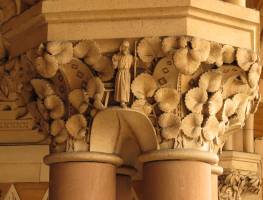

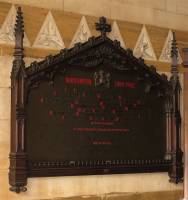
Our last pictures of the sculptural details, then, show a sample of the little figures amongst the foliage of the pillar capitals. In the upper row are merchants, craftsmen, and an alchemist apparently carrying out a distillation. The lower pair show a hunting scene, and a lively race. All of these works show a sympathetic treatment of the human figure in miniature, and a strong sense of decorative design.
Small figure sculpture on the capitals of the pillars.
This page was originally part of a 'sculpture of the month' series, for Aug 2015. Although the older pages in that series have been absorbed within the site, if you would wish to follow the original monthly series, then jump to the next month (Sept 2015) or the previous month (July). To continue, go to the bottom of each page where a paragraph like this one allows you to continue to follow the monthly links.
Architecture and architectural sculpture // Sculpture in some English towns
Visits to this page from 4 Aug 2015: 8,258